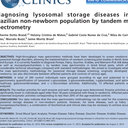Genotype-phenotype spectrum of PYCR1-related autosomal recessive cutis laxa.
Keywords
Abstract
Autosomal recessive cutis laxa type 2B (ARCL2B; OMIM # 612940) is a segmental progeroid disorder caused by mutations in PYCR1 encoding pyrroline-5-carboxylate reductase 1, which is part of the conserved proline de novo synthesis pathway. Here we describe 33 patients with PYCR1-related ARCL from 27 families with initial diagnoses varying between wrinkly skin syndrome, gerodermia osteodysplastica, De Barsy syndrome or more severe progeria syndromes. Given the difficult differential diagnosis of ARCL syndromes we performed a systematic comparison of clinical features of PYCR1-related ARCL. Intrauterine growth retardation, a characteristic triangular facial gestalt, psychomotor retardation, and hypotonia were the most relevant distinctive hallmarks of ARCL due to proline de novo synthesis defects. Corneal clouding or cataracts, athetoid movements, and finger contractures were rather rare features, but had a high predictive value. In our cohort we identified 20 different PYCR1 mutations of which seven were novel. Most of the mutations accumulated in exons 4 to 6. Missense alterations of highly conserved residues were most frequent followed by splice site changes and a single nonsense mutation. Analysis of genotype-phenotype correlation revealed that patients with mutations in the first two exons had lower average clinical scores and absent or only mild intellectual disability. Structural analyses predicted interference with PYCR1 multimerization for a subset of missense mutations. These findings have implications for the clinics as well as the pathomechanism of PYCR1-related ARCL.




